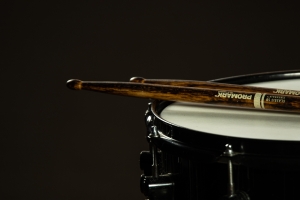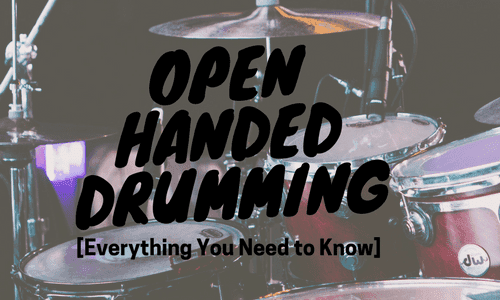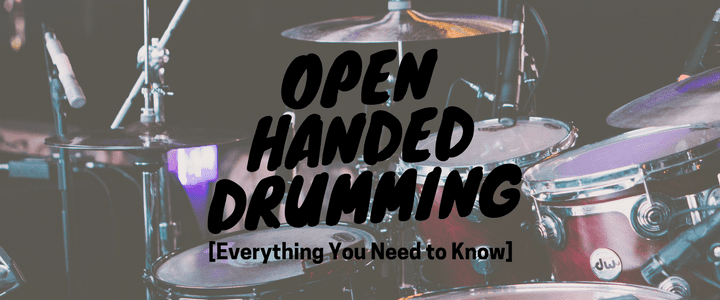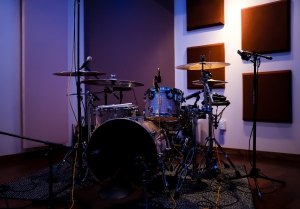It’s known by a few names: “Open handed drumming,” playing with a “left hand lead,” playing “uncrossed,” or simply “open.”
Whatever you decide to call it, open handed drumming is a way of setting up and playing your drum set so that one hand doesn’t cross over the other while playing the time-keeping cymbals (like the hi-hats, or ride).
It can equate to playing time with your non-dominant hand, and it also can mean playing the hi-hats or ride cymbals in unusual locations around the set to keep your hands from crossing.
In this article, we’ll share the proper way to learn the open handed drumming style, as well as its pros and cons. First, let’s take a quick look at how open handed drumming began.
How Do You Play Open Handed Drums?
To get started playing drums open handed, follow these steps:
- Set your drum kit up so that it accommodates for open handed drumming
- Repeat simple grooves with quarter notes on the hi hat first
- Focus on your timing and pace
- Practice open handed drumming exercises often
- Consider taking guitar lessons to master this technique
If you’re new to open handed drumming, you may find that watching videos of this technique is helpful. Here’s an example:
What is Open Handed Drumming?

Open handed drumming is a style of playing a drum kit that does not require you to cross your hands when playing the snare drum and hi-hat simultaneously.
It is not considered the traditional method of playing the drums – most people cross their hands (more on this later!) but it can be a great way for beginners to learn how to play.
There are many famous drummers who play open handed as well, including Dennis Chambers, Deen Castronovo, Steve Smith, Marco Minnemann, and more.
A Brief History of Open Handed Drumming
Open handed drumming is not a new phenomenon at all. When Jim Chapin’s book Advanced Techniques for the Modern Drummer was first published in 1948, he encouraged drummers to play with their hands “uncrossed.”
The first wave of high-profile open handed drummers came about in the mid ’60s, and it has continued through today. This is only a fraction of the well-known, open handed drummers:
- Gary Chester (studio drummer/author)
- Lenny White (Miles Davis, Return to Forever)
- Billy Cobham (Miles Davis, Mahavishnu Orchestra)
- Dennis Wilson (the Beach Boys)
- Joe English (Paul McCartney & Wings)
- Rayford Griffin (Jean-Luc Ponty)
- Scott Travis (Racer X, Judas Priest)
- Phil Gould (Level 42)
- Mike Bordin (Faith No More)
- Carter Beauford (Dave Matthews Band)
- Mike Mangini (Dream Theater)
- Bobby Jarzombek (Halford, Fates Warning)
Pros and Cons of Open Handed Drumming
Could this style of playing be right for you? Here are some of the pros and cons of open handed drumming to help you decide.
Advantages of Open Handed Drumming
The biggest advantage of open handed drumming is the most obvious one: ergonomics! You can set things up more easily to work with your arm and leg lengths, your hands don’t get in the way of each other, and you’ll be able to hit parts of your set without having to stop hitting another.
With your arms in an open position, your torso opens up, and your lungs can take in more oxygen, which is necessary for your muscles to work properly. Your posture is also likely to improve.
With open handed drumming, your hands can become equal strength partners. Making sure that you don’t have a “weak hand” opens up a lot of possibilities for you.
You can also get more creative with your set-up. With the parts of your drum set in non-traditional spots, your mindset will be different and your playing has a much better chance of sounding unique.
Working on open handed drumming can benefit ANY player, regardless of whether they’re right-handed or left-handed. It also works in ANY genre of music. There’s really no musical situation in which this approach wouldn’t work.
The Cons of Open Handed Drumming
The biggest con is that you might struggle to make your non-dominant hand do things it’s just not used to doing. It takes a lot of time, effort, and consistent practice to make it happen.
If you concentrate on open handed playing exclusively, you run the risk of having a hard time playing on other drum sets. On the flip side, if you’re the one providing a drum set for a multi-band event, other drummers will all have to adjust things to play on your set.
Another potential issue is cost. In order to place things in non-traditional spots around your drum set (for example, a hi-hat on the right side for a right-handed player), you might have to get some specialized hardware (like X-hat or cable hat rigs, percussion mounts and clamps, additional cymbal and snare stands).
SEE ALSO: 11 Drum Exercises for Speed, Independence, and Control
How to Get Started with Open Handed Drumming
If you’ve decided that you want to giv this technique a try, it won’t take much to get started! Here are a few simple steps you can take.
Open Handed Drum Kit Setup
The first step is simple – you’ve got to arrange your open handed drum setup so that it’s perfect for this style of drumming.
It sounds complicated, but it’s not. Just lower your hi-hat cymbals to a level that permits you to play them with your non-dominant hand comfortably, with all the stick angles of attack that you use with your dominant hand.
Open Handed Drum Technique
Next, begin to play very simple grooves with just quarter notes on your hi-hats at first, then eighth notes, and eventually, sixteenth notes.
Concentrate on the evenness and timing of your hats, but keep in mind that it’ll affect your snare drum hand and bass drum foot too, so remember to keep your hands and feet hitting together consistently.
Practice Often
At first, things will sound a little rough and ragged, but keep at it! Before you know it, it’ll start to sound a lot smoother. You can decide later if you want to move any other parts of your drum set around to experiment.
There are all kinds of open handed drumming exercises you can do to get the hang of this style, too. Here’s a video with some ideas of how you can get started:
Open Handed Drumming vs. Cross Handed
This kind of drumming is often considered as the alternative approach to the more traditional style of drumming, which is cross-handed drumming. With open-handed drumming, again, you will not cross your hands while playing between the hi-hat and the snare.
Why Do Drummers Play Cross Handed?
Crossing your hands isn’t necessary for playing the drums, yet so many drummers do it. You might be wondering why.
The simple answer is that most of us do this just because it was the way we were taught. Or, it might have been what we saw our drumming teachers or our drumming idols doing growing up.
There are benefits associated with playing cross handed – it’s a bit easier to learn and to set up your drum set for cross-handed drumming – but for some drummers, the advantages of this drum technique far outweigh those of cross handed playing.
Is Open Handed Drumming Bad?
It is not wrong to play open handed just as it is not wrong to play cross handed. Much like you are naturally right- or left-handed, neither technique is wrong or right.
Just make sure you set your drum set up accordingly depending on the style you choose!
As mentioned earlier, this is a technique with rich history and a lot of great, inspirational drummers choose to play this way. It takes some getting used to if you’ve already been drumming for a while, but there are several benefits that definitely make it worth considering.
To get the most out of your drum learning quest, it’s always best to work with an experienced drum teacher. There are lots of highly qualified teachers at TakeLessons, so you can be sure to find someone who’s a good fit for you and your needs. Best of luck learning these and other drumming techniques in your open handed drumming lessons!
 Post Author: Luc B.
Post Author: Luc B.Luc B. started teaching drums in 1992 and has experience performing in a variety of musical genres including rock, jazz, R&B, country, and reggae. He also studied Jazz and Contemporary Music at the University of Maine. Learn more about Luc here!
Jessica Dais






